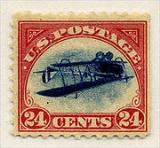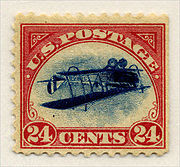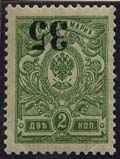
Invert error
Encyclopedia

Philately
Philately is the study of stamps and postal history and other related items. Philately involves more than just stamp collecting, which does not necessarily involve the study of stamps. It is possible to be a philatelist without owning any stamps...
, an invert error occurs when part of a postage stamp
Postage stamp
A postage stamp is a small piece of paper that is purchased and displayed on an item of mail as evidence of payment of postage. Typically, stamps are made from special paper, with a national designation and denomination on the face, and a gum adhesive on the reverse side...
is printed upside-down. Inverts are perhaps the most spectacular of a postage stamp error
Postage stamp error
A postage stamp error is any of several types of failure in the stamp printing process that results in stamps not having the intended appearance. Errors include use of the wrong colors, wrong denominations, missing parts of the design, misplaced or inverted design elements, etc...
s, not only because of the striking visual appearance, but because they are almost always quite rare, and highly valued by stamp collectors
Stamp collecting
Stamp collecting is the collecting of postage stamps and related objects. It is one of the world's most popular hobbies, with the number of collectors in the United States alone estimated to be over 20 million.- Collecting :...
.
Characteristics

A much less common situation is for the invert to be embedded into the printing plate or stone, most famously the Inverted Swan
Inverted Swan
The Inverted Swan, a 4-pence blue postage stamp issued in 1855 by Western Australia, was one of the world's first invert errors. Technically, it is a "frame invert"....
of early Western Australia.
An invert may be characterized as an "inverted center" or "inverted frame" when the underlying paper is watermark
Watermark
A watermark is a recognizable image or pattern in paper that appears as various shades of lightness/darkness when viewed by transmitted light , caused by thickness or density variations in the paper...
ed or otherwise carries a basic orientation. It is possible for a single-color stamp to be inverted relative to watermark, but this is called an "inverted watermark" rather than an "inverted stamp". Depending on the positioning of stamps within their sheet, the invert may be perfectly centered (as with the Inverted Jenny
Inverted Jenny
The Inverted Jenny is a United States postage stamp first issued on May 10, 1918 in which the image of the Curtiss JN-4 airplane in the center of the design was accidentally printed upside-down; it is probably the most famous error in American philately...
), or offset.

Dag Hammarskjöld invert
The Dag Hammarskjöld invert is a 4 cent value postage stamp error issued on 23 October 1962 by the United States Postal Service one year after the death of Dag Hammarskjöld, Secretary-General of the United Nations, in an airplane crash...
of 1962 consists only of a misprinted yellow layer, and it is not immediately clear that the white area is not a deliberate element of the design. Early Danish posthorn issues have an ornate frame that is almost perfectly symmetrical, and an inverted frame can only be detected by minute examination.
Overprint
Overprint
An overprint is an additional layer of text or graphics added to the face of a postage stamp or banknote after it has been printed. Post offices most often use overprints for internal administrative purposes such as accounting but they are also employed in public mail...
s may also be inverted. Many of these are common, since the expedient nature of many overprints means that the production process is not so carefully controlled.
Rare inverts often have significant monetary worth. Inverted Jennies have long sold for over 100,000USD apiece, and the St. Lawrence Seaway inverts of Canada approach those numbers. High prices for inverts have tempted printing company employees to steal misprinted sheets from the printing plant and attempt to pass them off as genuine, as in the 1996 case of the "Nixon invert
Nixon invert
The "Nixon invert" was a reputed invert error of the Richard Nixon memorial postage stamp issued by the United States in 1995. Originally reported in January 1996, it drew considerable attention that year; but in December a printing plant employee was arrested on charges of having stolen the...
".
US
- 1869 inverts (1869)
- Pan-American invertPan-American invertAs part of the Pan-American Exposition held in Buffalo in 1901 the United States Post Office Department issued a series of six commemorative stamps. The stamps were issued with ornate colored frames enclosing a black-and-white image of various means of transportation. In the standard American...
s (1901) - Inverted JennyInverted JennyThe Inverted Jenny is a United States postage stamp first issued on May 10, 1918 in which the image of the Curtiss JN-4 airplane in the center of the design was accidentally printed upside-down; it is probably the most famous error in American philately...
(1918) - Dag Hammarskjöld invertDag Hammarskjöld invertThe Dag Hammarskjöld invert is a 4 cent value postage stamp error issued on 23 October 1962 by the United States Postal Service one year after the death of Dag Hammarskjöld, Secretary-General of the United Nations, in an airplane crash...
(1962) - CIA invertCIA invertThe CIA invert is a one-dollar value postage stamp error issued by the United States Postal Service. It is one stamp from the Americana series that were produced between 1975 and 1981. The $1 colonial rushlight holder stamp was first issued on July 2, 1979 and one sheet of 100 stamps was issued...
(1976) - Nixon invertNixon invertThe "Nixon invert" was a reputed invert error of the Richard Nixon memorial postage stamp issued by the United States in 1995. Originally reported in January 1996, it drew considerable attention that year; but in December a printing plant employee was arrested on charges of having stolen the...
(1996) - Savings Bank invert

